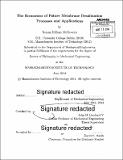The economics of future membrane desalination processes and applications
Author(s)
McGovern, Ronan Killian
DownloadFull printable version (15.76Mb)
Other Contributors
Massachusetts Institute of Technology. Department of Mechanical Engineering.
Advisor
John H. Lienhard V.
Terms of use
Metadata
Show full item recordAbstract
Seawater desalination, the desalination of waters flowing back from hydraulic fracturing processes and brackish water desalination constitute important desalination applications. These have a combined market size in excess of $25 billion per annum and a combined water production rate equivalent to the domestic consumption of over 300 million people. Each application offers its own distinct challenge. Reductions in energy consumption are key to driving down seawater desalination costs. The optimisation of water treatment in tandem with the formulation of fracturing fluids is key to reducing water management costs and environmental impacts in hydraulic fracturing. The development of desalination technologies that allow for high water recovery and high product purity is key to meeting industrial and municipal needs from brackish water sources. This thesis develops and investigates three emerging technologies: forward osmosis, electrodialysis at high salinity and hybrid electrodialysis-reverse osmosis with a view to addressing the three above challenges. Forward osmosis has often been viewed as a technology with the potential to reduce energy consumption in seawater desalination. An analysis is therefore undertaken into the theoretical limits upon its energy requirements paying particular attention to the energy penalty involved in drawing water from the feed stream into a more concentrated solution. Although unaddressed in literature this energy penalty is an important and distinguishing factor between FO and other desalination technologies. In the case of seawater, it is shown to put FO at a disadvantage that makes it difficult to compete with reverse osmosis. Consequently, it is argued that forward osmosis research should be reoriented away from seawater desalination to focus on alternate applications where salinities are above those which reverse osmosis can handle or where draw solution regeneration is not required. For these alternate applications a new framework is provided that explains the influence of the membrane orientation upon water flux through the membrane, an insight that is of particular use in considering the trade-off between water flux and fouling. The conventional view of electrodialysis is that it is most cost effective for the desalination of low salinity waters, and less so for moderate and high salinities, such as those encountered in waters that flow back from hydraulic fracturing processes. A thermoeconomic analysis of the effect of salinity upon cost reveals a different picture whereby electrodialysis is most cost effective removing salt from streams with between 1,000 ppm and 20,000 ppm of total dissolved solids. At lower salinities performance is hampered by low solution conductivity and low salt removal rates. At higher salinities the process is thermodynamically inefficient as the chemical potential of salt is raised only by a small amount when transported into the concentrate stream. The conclusion is that applications requiring salt removal within this 'sweet spot' for electrodialysis, such as the treatment of waste waters from flue-gas desulphurisation and coal-bed methane production, merit accelerated investigation. Incumbent technologies for the recycling of water produced from shales are currently inefficient and expensive. A study of electrodialysis energy requirements and equipment costs indicates that they are similar to, or even lower than, those for distillation. By developing a numerical model of system performance, which was validated over the range of 250 ppm to 192,000 ppm NaCl, it was possible to optimise the electrodialysis stack voltage and bring about cost savings of up to 30% in certain cases. These results and this numerical model warrant and will guide further investigations of electrodialysis under field conditions. Finally, a hybrid electrodialysis-reverse osmosis system was designed and optimised such that the reverse osmosis unit shifts salt removal in the electrodialysis unit into its sweet spot. The combination of these two technologies results in a system that provides enhanced product purity and product recovery at reduced cost. A simple rule of thumb is provided to guide practitioners in their choice between hybrid and standalone systems. This rule allows a choice to be made based on the relative cost of water from electrodialysis and reverse osmosis.
Description
Thesis: Ph. D., Massachusetts Institute of Technology, Department of Mechanical Engineering, 2014. Cataloged from PDF version of thesis. Includes bibliographical references.
Date issued
2014Department
Massachusetts Institute of Technology. Department of Mechanical EngineeringPublisher
Massachusetts Institute of Technology
Keywords
Mechanical Engineering.